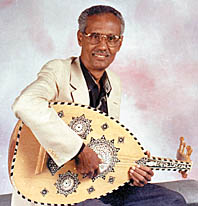
Abdul-Baqi Lectures on Yemei Music at AIYS [Archives:1998/28/Last Page]
July 13 1998

Mr. Abdul-Baqi is musical editor of the Yemen Times. The lecture was translated into English by Ahmad Hameed.
Mrs. Marta Colburn, the Resident Director of the institute told the Yemen Times, “One of the purposes of our regular monthly lectures is to help educate expatriates in Yemen about different aspects of Yemeni culture. So the idea was to have a summer series or summer events that would bring new people into our organization and to help them understand Yemeni culture. The idea of choosing Mr. Saleh for the function came about when the organizing committee read his articles on Yemeni music and songs in the Yemen Times. They wanted this knowledgeable man to come and participate.”
In his lecture on Yemeni music, Abdul-Baqi traced the Sana’ani song or muwashaha back in history. He said that it dates back to the time of the Andalucian muwashaha. The Arabs (including Yemenis), after conquering Spain, took with them music, literature and all types of art. The merger of that culture with the local art blended into the Andalucian muwashaha, which quickly gained fame.
The present poems, lyrics and melodies relating to muwashaha existing in Yemen came through old and famous Yemeni singers and composers. The tradition of the Yemeni lyric muwashaha, especially of Hadhramaut indicates that it is very refined, rich and sophisticated.
The Yemeni muwashaha absorbed the Arab makamat songs, well identified in Arab music. However, comparing the Yemeni and other types of muwashaha in the Arab world, we immediately notice the uniqueness in composition of the Yemeni version. But one characteristic common in all Arab muwashahas is the use of intones like bal baly, dan daa, laila dan, etc., which have no meaning but are used for the sake of perfecting rhythemic patterns. This proves that the Yemeni muwashaha is a part of the whole musical Arab spectrum.
The Yemeni muwashaha flourished during the Rasulid state when it was played in wedding parties and other occasions. It remained as late as the reign of Imam Yahia and his son Ahmed, who prohibited singing completely. Because of this prohibition, Yemeni singers used to meet secretly at the house of Saad Abdullah, one of the Yemeni muwashaha singers and composers in Aden. The purpose of the meetings was to apply new lyric poems to abandoned traditional rhythemic patterns.
Then, due to the establishments of gramophone companies in Aden, the Yemeni muwashaha started to cross the borders to neighboring countries. That phase was documented and it is still very popular.
One of the main contributions of Yemeni composers is the development of Yemeni Humaini poems. A lot of Yemeni songs are composed on the Humaini pattern. Ahmad Al-Shamy refers to the development of the Humaini poetry in his book “The History of Poetry in Yemen.”
So the muwashaha is a refined lyrical type of poetry composed by a singer and a composer at the same time. It is made up of three parts: a base or introduction, a structure and a closing.
Putting his theoretical lecture into an example, Saleh played some songs using the oriental lute (ud). He was able to capture the attention of the audience who was very responsive and applauded him with enthusiasism.
Then, Ahmad Taher Al-Adani played the mizmar (traditional reed flute) and Yahia Gadan tapped on the tambourine. That added more flavor to the performance, much to the excitement of the audience.
Whenever the players wanted to stop, the audience asked for more. It was fun.
The session ended with questions pertaining to the art of music.
By : Mohammed Hatem Al-Qadhi,
Yemen Times
——
[archive-e:28-v:1998-y:1998-d:1998-07-13-p:./1998/iss28/lastpage.htm]


